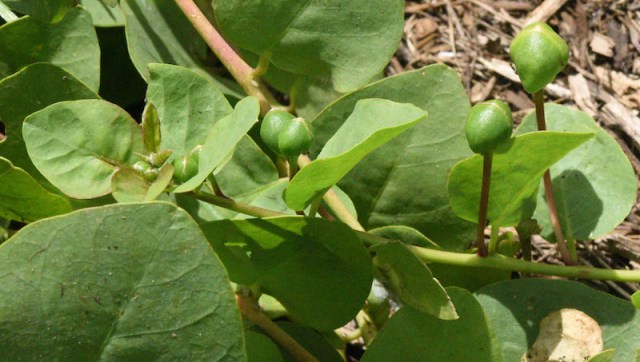I think of capers as the anchovies of the vegetable world, little parcels of flavored salt masquerading as food products. But they are much more than tidy, salty pickles…

They are would-be flowers, buds that if left to open and develop could yield fruit that might itself be pickled and marketed as caper berries. So capers have come to compete with themselves, creating a pickle of confusion. And of course it’s one or the other; you can’t have both, at least from a single bud.
The caper plant (Capparis spinosa) thrives in rocky outcrops around the Mediterranean. It’s a lax, almost viney short shrub, spreading from a central stem, forming flowers sequentially on new growth. The buds are plucked in early morning hours and then pickled and packaged.
Buds not harvested mature are allowed to open as handsome pinkish white flowers, marked by four sepals and four petals, cradling a handsome array of long stamens. Among the stamens you’ll spy the female element, a slightly thicker stalk that sports a small ovary at its tip – a stipitate (raised on a stalk) ovary. This kind of ovary defies the norms. Rather than being seated inside the flower, forming at the base of petals and stamens, it rides high on a slender stalk, called a gynophore (something that “bears” or supports the gynoecium).

If pollinated, the ovary matures as other flower parts fade, reaching the size and color of a small green olive. When ripe, the fruit, full of small seed, turns red. But just as we shortchange flowers in picking the immature buds to make capers, workers harvest the developed fruit while still green and tender, before it ripens and toughens.

Watching over Caper plants in your garden, it seems the flowers open in evenings and collapse with rising heat the next day, suggesting that in nature, flowers are moth-pollinated. I haven’t found information on pollination biology, but am on the search for that.
The many species of Capparis have been known and used by humans for millennia, such that today’s cultivated forms appear to be hybrids, which suggests the proper writing of the plant name includes a multiplication sign preceding the species, i.e. Capparis ×spinosa.
Joseph Miller (Botanicum Officinale, 1722) tells us about harvest, preparation, use, and virtues: The Caper-bush grows in the southern Parts of France and in Italy, in sandy and stony Places. The Capers that are brought over to us in Pickle are the Flowers of this Bush gather’d before they are blown open, laid a little to wither, and being put into Vinegar, remain there for eight days, and then are shifted; which is repeated a second time, and then they are barrel’d up for use. They are accounted a wholesome Pickle, pleasant and grateful to the Stomach, help the Appetite, provoke Urine, and are good against the Spleen and Jaundice. The Bark of the Root is heating and drying, opens Obstructions of the Liver and Spleen, is good in hypocondriac Disorders, and helps the Rickets.
More recently, you can discover a spate of articles examining differing possibilities for extracts from Capparis in a wide range of herbal and pharmaceutical applications. However, it isn’t clear any of those studies have uncovered remarkable new applications.
Rivera, Diego, C. Incencio, C. Obón, Encarna Careño, A. Reales, and Francisco J. Alcaraz, 2002. “Archaeobotany of capers ( Capparis ) (Capparaceae)”, in Vegetation History and Archaeobotany 11(4):295-314 DOI: 10.1007/s003340200042, https://www.researchgate.net/publication/225745506_Archaeobotany_of_capers_Capparis_Capparaceae